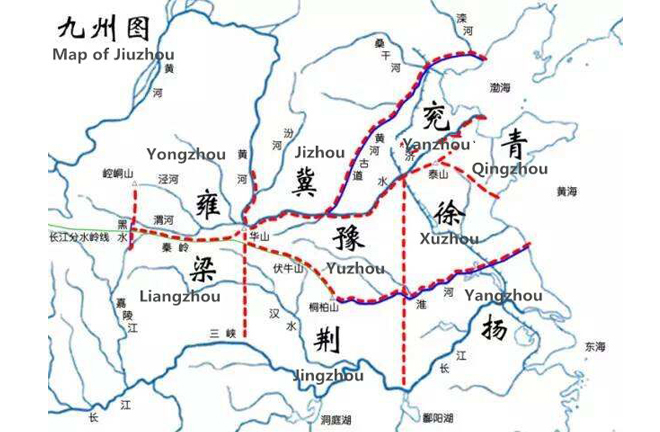Origin, development of jiuzhou concept

The map of jiuzhou in Yugong, which recorded the nine states divided by Yu when he tamed the flood.
EDITOR’S NOTE
According to a Chinese legend, circa 2000 BCE, the Yellow River basin was frequently troubled by floods. Yao, the emperor at the time, ordered a tribal chief named Gun to deal with the floods. However, Gun failed to solve the issue despite nine years of efforts. After Gun’s death, his son Yu took over his father’s job and successfully controlled the flood after 13 years of hard work, via dredging, in contrast to Gun’s method of “blocking the flood up.”
To cope with the troublesome floods, Yu divided ancient China into nine states, known as “jiuzhou” (literarily, jiu meaning “nine” and zhou meaning “state”), according to the unique geographic features of each. Jiuzhou included Jizhou, Qingzhou, Xuzhou, Yanzhou, Yangzhou, Liangzhou, Yuzhou, Yongzhou and Jingzhou. Since then “jiuzhou” has emerged as a special concept and was recorded in Yugong, a chapter in the Confucian classic the Book of Documents, also known as Shangshu.
The legend of “Yu taming the flood” and “dividing China into nine states” has had a far-reaching impact on Chinese history. The relevant document, Yugong, the earliest book on geography in China, has long interested scholars. On Oct.28, scholars discussed the origins of the concept “jiuzhou,” and ways to better understand the relevant history at a seminar held by the School of History and Culture of South China Normal University (SCNU).
Popular in Western Zhou Dynasty
Xin Deyong, a professor of history at Peking University, argues that Yugong was traditionally thought to be a book handed down from the Xia Dynasty (c. 2070-1600 BCE). In the 1840s, a group of scholars represented by Gu Jiegang (1893-1980), the founder of historical geography in China, started to question it. Gu argued that Yugong was written in the Warring States period (475-221 BCE).
In recent decades, with the development of Neolithic archeology, as well as the unearthing of documents of Western Zhou Dynasty (1046-771 BCE) bronzeware and the Warring States period, some scholars put forward different views on when Yugong was authored. Xin said some of Gu’s work contains incontrovertible evidence on when Yugong was written.
Zhang Shuyi, a professor of history and culture at SCNU, said according to the evidence of the inscriptions of “Suigong Xu” and “Yiyizhong,” as well as “The Warriors of Shang,” “Eternities” and “The Swallow” in the Book of Poetry, the legend of Yu dividing China into jiuzhou originated quite early and was widely disseminated during the Western Zhou Dynasty.
During the Shang Dynasty (1600-1046 BCE), there was an approach to geography that involved choosing a central location and extending the knowledge of areas around it. This shows that in the Western Zhou Dynasty people’s concept of “Yu dividing jiuzhou” can be theoretically established. In the evolution of the legends of the Western Zhou Dynasty to the Warring States period, the concept and spatial scale of state, was greatly expanded, and the influence of Yu’s traces of taming floods was interpreted in various ways.
Reflection of social reality
In terms of the connotations and changes to the concept “jiuzhou,” Chen Lizhu, a professor from the School of History and Culture at South China Normal University, said jiuzhou referred to the Central Plains in ancient China. After experiencing tremendous changes in the Shang and Zhou dynasties, people at that time began to seek reasons for various changes in daily life.
They realized that destiny cannot explain everything, and human behavior was the key to understanding the world. They started to compare the past with present, and produced a “sense of historical rationality,” which gradually replaced superstitions in terms of concepts of the past. It also laid the foundation for people to reinterpret the meaning of “jiuzhou.” Entering the Spring and Autumn (770-476 BCE) and Warring States periods, the collapse of the ritual system and social turbulence resulting from kingdoms seeking hegemony broke the “one center” view of the world. Against this backdrop, the hundred schools of thought emerged as a new historical space and the global situation required a new outlook on the world. Accordingly, jiuzhou did not mean the Central Plains as a whole, but referred to nine states in a real sense.
Shen Changyun, a professor of history and culture from Hebei Normal University, argued that the historical significance of Yugong is more a reflection on the achievements of Emperor Hui of the Wei kingdom (403-225 BCE) and the overall mentality of the society. He pointed out that at present, most academics think that Yugong was written by the people from the Wei Kingdom in the late Warring States period.
Though Yugong is talking about the division of jiuzhou, it actually emphasizes the tribute system of the states to the central court. This is not so much a retrospective of history, as what depicted was the social background in which the author lived. Or the author conceived a blueprint for a great national integration in the future. The Hui Emperor was the first among the emperors to have this ambition. In Yugong, Jizhou is taken as the primary state of the nine states, the destination for all articles of tribute and functioned as the capital suburb, Shen added.
